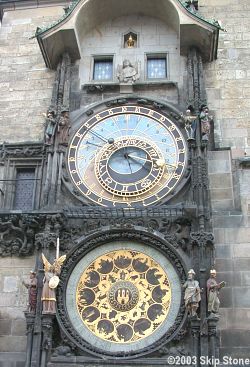
In Prague’s Old Town Square is a clock that has held the public’s fascination since it was built in 1410 by clockmaker Mikulas of Kadan, with an astronomer and professor of mathematics named Jan Sindel. Years and centuries in the making, work continued in fits and starts, with gaps of a hundred years or more until the clock as we know it now was finished in 1866.
Sadly, the whole tower and clock were severely damaged during the Nazi occupation and ensuing uprising in Prague of 1945. The entire building was burnt to the ground, including all of the city’s archives, by the Nazi’s.
Happily, the residents of Prague gathered together after the war and repaired it, with all mechanisms returning to full action in 1948. In 1979 the clock underwent major repairs once again, and is destined for extensive maintenance to keep it “ticking” into the future.
What do the dials tell us?

The Orlog tells us the exact position of the sun and stars in relative position to Earth. It’s most accurate when the sun is directly overhead, as it was designed to be timed with sundials originally. This clock was built when mechanisms were highly inaccurate, and were retimed to a more accurate clock (a sundial) every day. The sundials were removed in 1911.
Originally the Orlog displayed exclusively astronomical data and there were no cute little mechanical figures to entertain folks, but only showed purely astronomical information.
Now the top part of the clock is known as “The Walk of the Apostles” and is the show part of the clock. Every hour on the hour – Death, represented by a skeleton, rings a bell. Then the windows open and the Christian Apostles march by. The windows close, a golden cockerel crows, and then the chimes of the hour can be heard. All of this is accompanied by a Turk playing a flute, a Miser shaking his cane and watching his bag, and Vanity admiring himself in a mirror.
The Sphere or clock dial is the middle of the Orloj and shows astronomical phenomena such as sunrise and sunset, ancient Czech and modern times, the movements of the Sun and Moon and other celestial bodies. The three pointers are for the Sun, the Moon and the Zodiac. The ball is half silvered and half black, and rotates every lunar month and shows the moon’s phases.

The bottom dial is the Calendar, with copies of the original month symbols painted by Josef Manes in 1805. These original artworks were preserved, and are now on display in the Prague Museum of History.
There are lots of interesting tales about this fabulous clock with it’s moving figures, windows that open and close, and of course, astronomical information. Twice during it’s history the City of Prague nearly sold it for scrap metal, the Nazi’s deliberatly tried to blow it up with artillery, and time has ravaged it unkindly.
The most famous legend about the clock is about the master clockmaker Hanus, who had his eyeballs burned out with a hot poker by the city councillors, in an effort to keep him from creating another clock of equal or greater magnificence elsewhere. Hanus in revenge then climbed the tower and damaged it so greatly that it didn’t run for many years until repaired. It is also said that the skeleton has magical powers that require the clock to keep running. And, locals say, if the clock is allowed to fall into disrepair the city also suffers.
So the Orloj keeps on running, with a lot of love, care and respect from the residents of this magical city.

